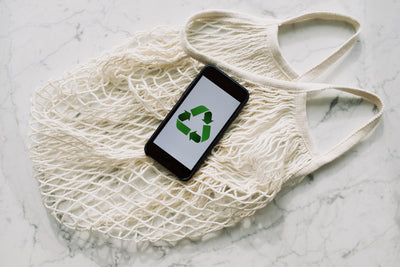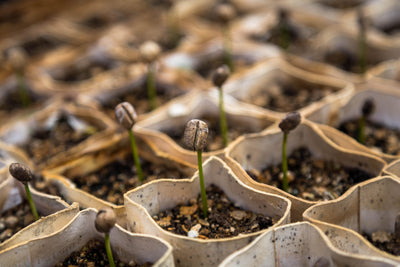Facts About Paper Waste: 7 Ways To Reduce Your Waste
June 14, 2021Wrapping paper, books, paintings, maps of the world. All of these items are made using paper. But for all their important use cases comes a footprint as well. A footprint that was a lot more sustainable when there were far fewer human beings on the earth. There are eight billion people and rising, which has changed things. Below, we take a look at just how big the footprint of paper waste really is.
Paper Waste: The Facts & Statistics
- The paper industry creates the third largest amount of greenhouse gasses in Canada. In the US it is the sixth largest producer of greenhouse emissions.
- Around 40% of all deforestation is caused by the paper and pulp industries.
- Paper production causes significant amounts of air pollution. In the US in 2015, it was the second largest cause of air pollution by industry.
- It takes over 13 liters of water (or three gallons) to make a single piece of A4 paper.
- Over 380 gallons of oil is used to produce a single ton of paper.
- On average, office workers were printing fifty unnecessary pieces of paper every day less than just 15 years ago.
- Around 26% of the material at landfills is waste paper.
Toilet Paper Wastage

Approximately 27,000 trees are cut down every day just to make toilet paper. Over seven billion rolls of toilet paper are sold in America alone each year. This amounts to around 141 rolls per person, or 12.7 kilograms (28 lbs.) of paper. Comparable figures can be found in many major European countries. In Germany, they use 134 rolls per person every year. Similarly, in the UK it’s 127 rolls per person annually. Clearly, this is an unsustainable practice.
That being said, many other countries do a better job at paper usage and wastage. This is often due to the use of alternative hygiene practices, such as bidets. To lessen this environmentally devastating practice, more people need to adopt similar approaches.
What To Do To Reduce The Paper Waste

1. Recycle All Paper Waste
The most urgent step that needs to be taken is to start recycling all paper wastes. The more that can be recycled, the more trees that can be saved. Given the worrying rate of our planet’s deforestation, this is a vital adjustment. It will also reduce the levels of air and water pollution that the process of making paper creates.
2. Go Paperless - Review & Store Documents Digitally
In the long term, it’s vital that everyone makes the switch from paper to digital documents. Before you print anything out, consider whether you really need a physical copy. In most cases, you can now just rely on e-documents. Books can be read on kindles, phones, or tablets. E-tickets can be used for many public modes of transportation. Wherever possible, stick to a digital rather than a paper document. This will dramatically reduce paper wasting.
3. Use Recycled Paper At Home And In The Office
In the rare instances where you do need to print out documents, only use recycled paper. This way, at the very least you’ll not be contributing to deforestation. Try to encourage your place of work to only purchase recycled paper too.
4. Use Both Sides When Printing & Copying
Relatedly, when you can’t avoid printing or copying, be sure to use both sides of the paper. While this may seem unimportant, doing this halves the amount of paper you use. Over the long term, this can save large amounts of paper from being wasted.
5. Adjust Fonts & Formatting To Limit Wasted Space
Another way to reduce the volume of paper you use when printing and copying is to adjust the typography. Pick a font that reads well even when small, and then lower its size as much as possible. Thereafter, adjust the margins so that they’re narrower. It will allow you to fit more content onto each individual page.
6. Reuse Paper Whenever Possible
Once a paper document has served its purpose, don’t immediately send it to the recycling bin. You can repurpose it first, thereby getting more use out of it. For instance, you can use it to take minutes during a meeting. If you enjoy drawing, use it as a blank canvas for your art. Just still be sure you do recycle the paper once you’re completely finished with it.
7. Buy Products With The Least Packaging
Always look for the products that come with the least amount of packaging. There are now plenty of companies that are environmentally conscious. As such, they’ll try to limit the waste their products will create. It’s also a good idea to buy products in higher volumes where possible. This cuts down on the overall amount of packaging over time.
Paper Waste: Solving The Problem
As this article has demonstrated, the world is facing a serious problem with paper waste. This is contributing to the climate crisis through deforestation and pollution. If we carry on at the current rate, we risk causing irreparable damage.
However, there are things people can do to alleviate these problems. By following the steps above, you’ll be going some way towards helping divert a catastrophe. Consider getting a bidet instead of using toilet paper, switching to digital documents instead of paper ones, and always reuse and recycle paper.
By following these simple guidelines, we’ll dramatically reduce our paper use. Let’s save the world together, starting with less paper wasted.
MORE Going Zero Waste ARTICLES View all ›
Ready to make
the switch?
- Powerful Cleaning
- Dissolves Easily
- Skin-Friendly
- Eco-Friendly
- No Mess














